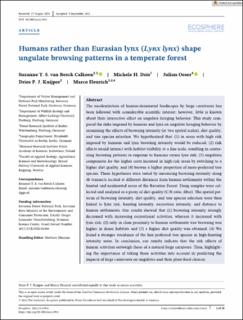| dc.contributor.author | van Beeck Calkoen, Suzanne T. S. | |
| dc.contributor.author | Deis, Michele H. | |
| dc.contributor.author | Oeser, Julian | |
| dc.contributor.author | Kuijper, Dries P. J. | |
| dc.contributor.author | Heurich, Marco Dietmar | |
| dc.date.accessioned | 2022-08-31T09:02:06Z | |
| dc.date.available | 2022-08-31T09:02:06Z | |
| dc.date.created | 2022-05-24T13:27:15Z | |
| dc.date.issued | 2022 | |
| dc.identifier.citation | Ecosphere. 2022, 13 (2), . | en_US |
| dc.identifier.issn | 2150-8925 | |
| dc.identifier.uri | https://hdl.handle.net/11250/3014645 | |
| dc.description.abstract | The recolonization of human-dominated landscapes by large carnivores has been followed with considerable scientific interest; however, little is known about their interactive effect on ungulate foraging behavior. This study compared the risks imposed by humans and lynx on ungulate foraging behavior by examining the effects of browsing intensity (at two spatial scales), diet quality, and tree species selection. We hypothesized that: (1) in areas with high risk imposed by humans and lynx browsing intensity would be reduced; (2) risk effects would interact with habitat visibility at a fine scale, resulting in contrasting browsing patterns in response to humans versus lynx risk; (3) ungulates compensate for the higher costs incurred in high-risk areas by switching to a higher diet quality, and (4) browse a higher proportion of more-preferred tree species. These hypotheses were tested by measuring browsing intensity along 48 transects located at different distances from human settlements within the hunted and nonhunted areas of the Bavarian Forest. Dung samples were collected and analyzed as a proxy of diet quality (C:N ratio, fiber). The spatial patterns of browsing intensity, diet quality, and tree species selection were then linked to lynx risk, hunting intensity, recreation intensity, and distance to human settlements. Our results showed that (1) browsing intensity strongly decreased with increasing recreational activities, whereas it increased with lynx risk; (2) only in close proximity to human settlements tree browsing was higher in dense habitats and (3) a higher diet quality was obtained. (4) We found a stronger avoidance of the less preferred tree species in high-hunting intensity areas. In conclusion, our results indicate that the risk effects of human activities outweigh those of a natural large carnivore. Thus, highlighting the importance of taking those activities into account in predicting the impacts of large carnivores on ungulates and their plant-food choices. | en_US |
| dc.language.iso | eng | en_US |
| dc.rights | Navngivelse 4.0 Internasjonal | * |
| dc.rights.uri | http://creativecommons.org/licenses/by/4.0/deed.no | * |
| dc.subject | ambush predator | en_US |
| dc.subject | browsing intensity | en_US |
| dc.subject | diet quality | en_US |
| dc.subject | diet selection | en_US |
| dc.subject | human activities | en_US |
| dc.subject | hunting | en_US |
| dc.subject | predation risk | en_US |
| dc.subject | predation risk | en_US |
| dc.subject | recreation | en_US |
| dc.title | Humans rather than Eurasian lynx (Lynx lynx) shape ungulate browsing patterns in a temperate forest | en_US |
| dc.title.alternative | Humans rather than Eurasian lynx (Lynx lynx) shape ungulate browsing patterns in a temperate forest | en_US |
| dc.type | Peer reviewed | en_US |
| dc.type | Journal article | en_US |
| dc.description.version | publishedVersion | en_US |
| dc.subject.nsi | VDP::Matematikk og Naturvitenskap: 400 | en_US |
| dc.source.pagenumber | 0 | en_US |
| dc.source.volume | 13 | en_US |
| dc.source.journal | Ecosphere | en_US |
| dc.source.issue | 2 | en_US |
| dc.identifier.doi | 10.1002/ecs2.3931 | |
| dc.identifier.cristin | 2026978 | |
| cristin.ispublished | true | |
| cristin.fulltext | original | |
| cristin.qualitycode | 1 | |

